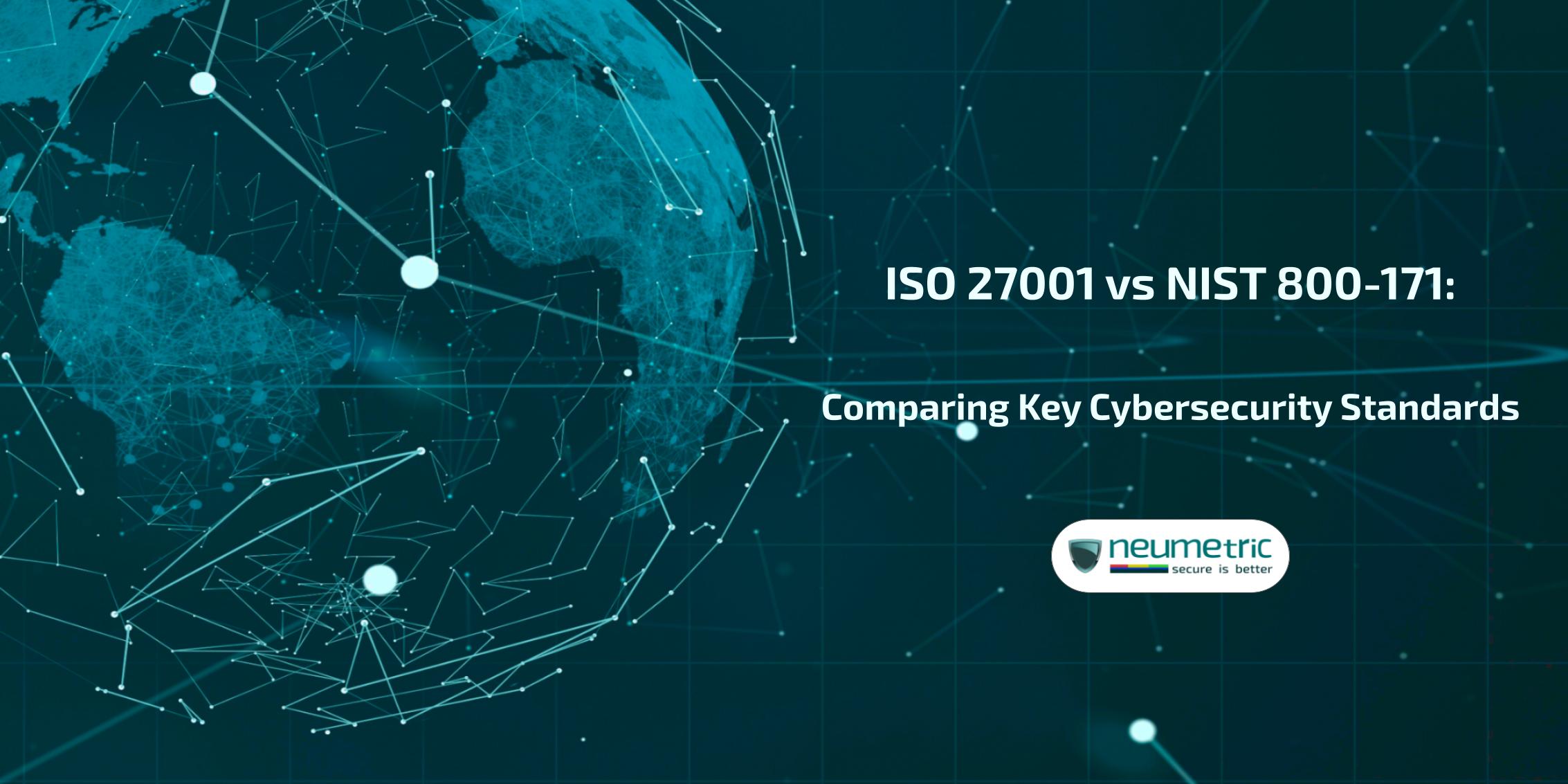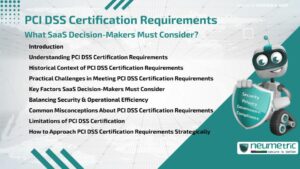Table of Contents
ToggleIntroduction
As cybersecurity threats continue to rise globally, businesses must take proactive steps to protect sensitive information. Implementing effective cybersecurity measures not only helps to safeguard data but also boosts an organization’s credibility & reputation. For companies seeking guidance on Information Security Management, ISO 27001 vs NIST 800 171 are two (2) of the most widely recognized frameworks.
Both frameworks offer detailed guidelines for securing information, but they target different industries, geographical regions & types of information. ISO 27001 is a global standard that addresses information security for all types of sensitive data, while NIST 800-171 is focused specifically on protecting Controlled Unclassified Information [CUI] in U.S. government contracts.
In this journal, we will compare these two frameworks in detail to help organizations determine which standard best suits their needs, whether they are aiming for broad international compliance or specific adherence to U.S. government regulations.
What is ISO 27001?
Overview of ISO 27001
ISO 27001 is part of the ISO/IEC 27000 family of standards, which focuses on Information Security Management Systems [ISMS]. The full title of ISO 27001 is ISO/IEC 27001:2013 & it was developed by the International Organization for Standardization [ISO] in collaboration with the International Electrotechnical Commission [IEC]. The standard provides a framework for managing & protecting sensitive company data through the establishment of an ISMS.
ISO 27001 covers various aspects of security, from physical security to cybersecurity & addresses risks related to data confidentiality, integrity & availability. The standard takes a risk-based approach, meaning organizations must identify potential risks & vulnerabilities in their information systems & adopt appropriate controls to mitigate those risks.
Key Features of ISO 27001
- Risk Management: A fundamental component of ISO 27001 is its emphasis on risk management. Organizations must assess & manage security risks based on the likelihood & impact of potential threats. This approach helps prioritize resources & mitigate threats effectively.
- ISMS Approach: ISO 27001 helps organizations develop a systematic Information Security Management System [ISMS]. This includes defining Information Security Policies, setting objectives, establishing risk management processes & implementing controls to protect sensitive data.
- Continuous Improvement: ISO 27001 follows the Plan-Do-Check-Act [PDCA] model, which encourages organizations to constantly improve their security practices & processes. This framework ensures that security measures evolve to stay ahead of emerging threats & challenges.
- Global Certification: Organizations that meet the requirements of ISO 27001 can earn certification, which is globally recognized & provides an assurance to clients, stakeholders & regulators of the organization’s commitment to information security. This certification can provide a competitive advantage & demonstrate compliance with best practices in information security.
What is NIST 800-171?
Overview of NIST 800-171
NIST 800-171 is a cybersecurity framework developed by the National Institute of Standards & Technology [NIST], specifically for organizations handling Controlled Unclassified Information [CUI] in non-federal systems. CUI refers to sensitive information that requires protection but is not classified under national security laws. NIST 800-171 offers detailed guidance on how to secure CUI, ensuring that organizations meet the U.S. government’s cybersecurity requirements when handling such data.
The framework is primarily aimed at U.S. federal contractors, particularly those in the defense, aerospace & information technology sectors. NIST 800-171 is part of the NIST Special Publication 800-series, which provides guidelines for improving cybersecurity across various industries. NIST 800-171 is often a requirement for federal contractors under the Federal Acquisition Regulation [FAR] & Defense Federal Acquisition Regulation Supplement [DFARS].
Key Features of NIST 800-171
- Protecting CUI: NIST 800-171 specifically focuses on safeguarding Controlled Unclassified Information [CUI]. This is particularly important for U.S. Federal Contractors, as they may handle sensitive government data that must be protected to meet regulatory requirements.
- Fourteen (14) Control Families: The framework outlines fourteen (14) security control families, covering areas such as access control, incident response, system & communications protection & security assessment. Each family includes detailed security requirements designed to secure CUI across various systems & processes.
- Compliance for Federal Contractors: For contractors working with U.S. Government Agencies, compliance with NIST 800-171 is often a prerequisite for bidding on or maintaining contracts involving CUI. This ensures that contractors can meet federal cybersecurity expectations & protect government data.
ISO 27001 vs NIST 800-171: Key Differences
When comparing ISO 27001 vs NIST 800-171, it’s essential to understand the key differences in scope, structure & implementation.
Scope & Purpose
- ISO 27001 is a broad, global standard applicable to all types of sensitive data. It is designed to address the comprehensive needs of Information Security Management in a wide range of industries, from healthcare to finance & manufacturing.
- NIST 800-171 is narrower in focus, specifically targeting organizations that need to protect Controlled Unclassified Information [CUI]. It is primarily relevant for organizations in the United States working with government contracts, particularly in defense & other sensitive sectors.
Framework Structure
- ISO 27001 focuses on the establishment of a comprehensive Information Security Management System [ISMS]. The framework encourages organizations to develop a risk-based approach, identifying potential vulnerabilities & applying security controls to mitigate these risks. It is more flexible & adaptable to different types of organizations.
- NIST 800-171 is highly prescriptive, providing specific security controls divided into fourteen (14) families, each containing detailed requirements for securing CUI. These controls are much more specific than ISO 27001’s guidelines, providing a clear roadmap for meeting federal cybersecurity expectations.
| Aspect | ISO 27001 | NIST 800-171 |
| Scope | Broad, covers all types of sensitive data | Focused on CUI protection in U.S. government contracts |
| Framework Structure | Risk-based approach, ISMS model | Prescriptive security controls divided into 14 families |
Implementation Requirements
- ISO 27001 requires the establishment of a formal ISMS within the organization. This includes setting security objectives, conducting risk assessments & applying appropriate controls. Organizations are also required to engage in regular audits & assessments to ensure ongoing compliance & improvement.
- NIST 800-171 does not require the establishment of a formal management system like ISO 27001 but provides a set of prescribed security requirements that organizations must follow to ensure the protection of CUI. These requirements are more focused on specific actions to be taken rather than a broader organizational approach.
Compliance & Certification
- ISO 27001 provides certification for organizations that meet its requirements. This certification is internationally recognized & can be used to demonstrate an organization’s commitment to information security. It is particularly useful for organizations that operate across multiple countries & industries.
- NIST 800-171 does not offer certification. Compliance is typically verified through self-assessment or third-party audits, but there is no formal certification process. Instead organizations must demonstrate that they have implemented the necessary controls to protect CUI, which is often subject to audit by federal agencies or contractors.
| Framework | Certification | Compliance Verification |
| ISO 27001 | Yes | Audited by certifying bodies |
| NIST 800-171 | No | Self-assessment or third-party audits |
Why Should You Care About ISO 27001 & NIST 800-171?
Understanding ISO 27001 vs NIST 800-171 is crucial for any organization involved in data security. Let’s explore why you should care about these frameworks:
Industry Requirements & Regulatory Compliance
For organizations handling sensitive data, particularly those involved in government contracts, both frameworks help ensure compliance with industry-specific regulations. ISO 27001 is essential for organizations seeking international recognition for their security practices, while NIST 800-171 is a requirement for U.S. federal contractors working with CUI.
Risk Management
Both frameworks emphasize risk management. Implementing these standards helps organizations identify & address security risks, safeguarding data & reducing the likelihood of breaches or cyberattacks. By following a structured approach to identifying risks & applying mitigations organizations can significantly improve their security posture.
Competitive Advantage
Certification in ISO 27001 provides a competitive advantage, particularly for businesses operating globally. It assures clients, partners & regulators that your organization is committed to information security, enhancing trust & credibility. Organizations with ISO 27001 certification are often seen as more secure & reliable partners, which can translate to new business opportunities.
Challenges in Implementing ISO 27001 & NIST 800-171
While both frameworks offer valuable guidelines organizations may face challenges during implementation:
Resource Intensity
Implementing ISO 27001 & NIST 800-171 requires significant resources. Smaller organizations may struggle to allocate the necessary time, personnel & financial resources to comply with these frameworks. Developing an ISMS or meeting the detailed requirements of NIST 800-171 may require specialized personnel, training & tools.
Complexity
The detailed requirements of both ISO 27001 & NIST 800-171 can be overwhelming, particularly for organizations without dedicated cybersecurity teams. Both frameworks demand regular audits, risk assessments & continuous monitoring, which can be resource-intensive. Additionally, the complexity of implementing comprehensive security controls can pose a challenge for businesses with limited expertise.
Organizational Buy-in
Gaining support from senior management & other key stakeholders is essential for the successful implementation of these standards. Without strong commitment at all levels of the organization, efforts to implement these frameworks may falter. Leadership must ensure that cybersecurity is prioritized across all departments & functions.
Potential Counterarguments
Despite the benefits, there are counterarguments to adopting ISO 27001 & NIST 800-171:
Cost of Implementation
For smaller businesses, the financial & resource burden may outweigh the perceived benefits of certification or compliance. The costs associated with training, auditing & maintaining compliance can be significant, especially for organizations without dedicated cybersecurity resources.
Overlap with Existing Standards
Organizations already adhering to other cybersecurity standards (such as NIST Cybersecurity Framework or GDPR) may find the additional requirements of ISO 27001 or NIST 800-171 redundant. The overlap may lead to inefficiencies & a perceived duplication of effort, making it difficult to justify additional certification or compliance efforts.
Complexity
Smaller or less regulated industries may not require the high level of complexity that these frameworks demand. For example, startups or organizations in low-risk sectors may find the formal implementation of ISO 27001 or NIST 800-171 to be unnecessary or too complex for their needs.
Conclusion
The comparison between ISO 27001 vs NIST 800-171 highlights the distinct roles each framework plays in securing sensitive information. While ISO 27001 provides a comprehensive, global approach to information security management, NIST 800-171 offers specific guidelines for U.S. federal contractors handling Controlled Unclassified Information.
Organizations must evaluate their own needs, regulatory requirements & the nature of the data they handle before deciding which framework to adopt. Understanding the nuances of both standards will help organizations develop robust cybersecurity practices that protect sensitive data & ensure compliance with industry regulations.
Key Takeaways
- ISO 27001 offers a global, comprehensive approach to Information Security Management, suitable for a wide range of industries.
- NIST 800-171 is focused specifically on U.S. government contractors that need to protect Controlled Unclassified Information [CUI].
- ISO 27001 provides certification, while NIST 800-171 does not.
- The decision between these frameworks depends on your organization’s industry, location & the types of sensitive information it handles.
Frequently Asked Questions [FAQ]
What is the main difference between ISO 27001 & NIST 800-171?
ISO 27001 is a global standard for Information Security Management, whereas NIST 800-171 focuses specifically on protecting Controlled Unclassified Information [CUI] for U.S. government contractors.
Do I need to comply with both ISO 27001 & NIST 800-171?
It depends on your industry. If you are a U.S. federal contractor working with CUI, you must comply with NIST 800-171. If you need global certification for information security, ISO 27001 may be more suitable.
Can I get certified in NIST 800-171?
No, NIST 800-171 does not offer certification. However organizations can verify compliance through self-assessment or third-party audits.
How long does it take to implement ISO 27001 or NIST 800-171?
Implementation can take several months to a year, depending on the complexity of your organization & its existing cybersecurity practices.
Is one framework better than the other?
Neither framework is inherently better than the other. The choice depends on the specific needs of your organization, including industry, regulatory requirements & data protection needs.





